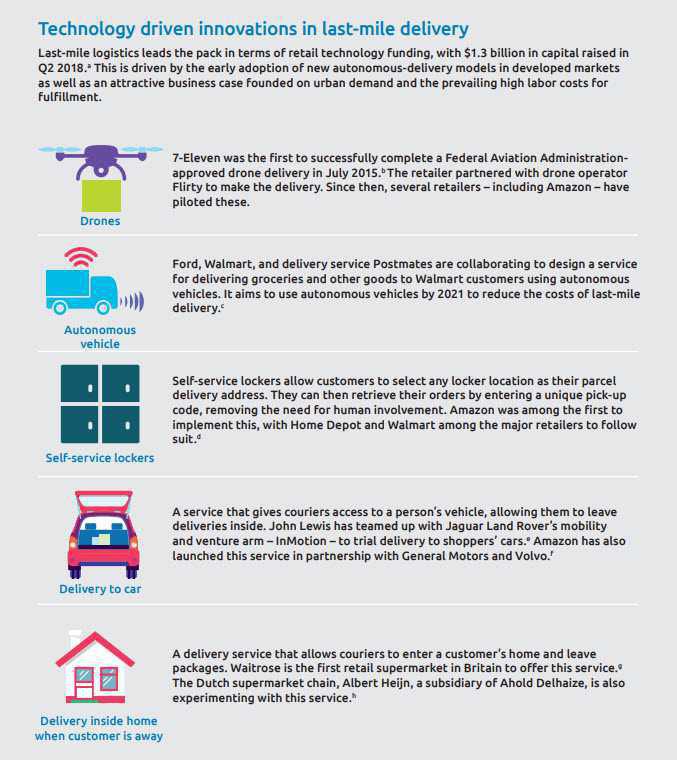This 40 page report from Capgemini examines how to address the growing demand for immediate delivery, in particular for groceries, with technology and land uses. This "last mile" delivery refers to the final part of a journey where a customer takes ownership of an ordered product. The report covers five countries and includes the results of research, analysis, and interviews.
Benefits & Problems Addressed
Need for profitable last mile business model: Current delivery models are not proving to be profitable, with retailers absorbing a part of the cost of last-mile delivery.
Growth: 40% of consumers now rank delivery services as a “must-have” feature for food and grocery purchases. As of October 2018, venture capital firms have invested $3.5 billion in food and grocery delivery services.
Tips & Techniques
How to Use the Report: For use by mobility, retail, and land use planners in the public and private sectors who are addressing the growing benefits and challenges related to e-commerce and deliveries. The report includes several recommendations for creating a sustainable last mile delivery ecosystem. For cities, there are subtle implications for urban design and mobility systems.
Report Structure: The report investigates: (1) Consumers’ increasing desire for faster and more frequent deliveries, (2) The benefits for firms that offer great last-mile delivery services, (3) The impact of increases in last-mile deliveries on profitability, and (4) How organizations can get the last-mile value proposition right while mitigating profitability risks.
Key Findings on Consumers: (1) 59% of consumers purchase items online when they need them or on demand rather than waiting until the weekend to purchase in store; this will drive demand for 2 hour (not just 24 hour) delivery expectations, (2) However, 73% of consumers said that receiving the delivery in a convenient time slot is more important than receiving it quickly, (3) On-going satisfaction is critical; 74% of satisfied consumers intend to increase purchase levels by 12% with their preferred retailer. Of note, 55% of consumers are willing to deliver products to neighbors in their vicinity, which brings a new kind of commercial activity to residential neighborhoods.
Key Findings on Firms: 96% of consumer product firms (n=500) see subscription models as a means to provide more convenience and value to customers. As more brands start delivering orders to consumers directly, collaboration for shared delivery logistics will become increasingly important. 97% of interviewed firms are considering joining forces with other consumer product firms to create shared warehouses and logistics for last-mile delivery.
Storefronts and Warehouses: While larger firms will likely automate larger warehouses for cost savings, smaller stores will turn to fulfillment services that delivery for multiple commercial entities. Retail operations with a storefront will use both the active front area and backroom fulfillment for deliveries. This will add activity in the back of retail, now mainly designed to take intermittent deliveries. "Dark stores" will proliferate and are designed just for pick up. Lockers will also be strategically placed in a first/last delivery ecosystem. Experiential retail will continue to rise; 57% of consumers said that they prefer to go to stores if there are additional activities such as cookery or bakery classes
Examples: (1) Walmart recently launched a pilot run of its last mile grocery delivery service – Spark Delivery. It’s a crowd-sourced delivery platform, where independent drivers pick up customer orders from Walmart stores and warehouses and deliver them where and when the customer wants, (2) Major US retailer Target acquired Shipt, an online, same-day delivery startup to offer same-day delivery, (3) Instacart – a grocery delivery startup founded in 2012 – recently raised nearly $871 million, valuing the company at $7.87 billion.
Hot Buttons: For cities, current delivery pain points (curbside congestion, package handling in commercial buildings) will increase and expand. The need for 2 hour delivery may place speed over safety in the race to maintain loyalty,. In addition, the ability to order continuously throughout the day will likely increase traffic and congestion among several delivery modes (autonomous deliverybots, drones). Firms also are looking at "dark stores" for fulfillment, which detracts from activity needed for engaging streetscapes.
Resource
The Last-Mile Delivery Challenge, Capgemini Research Institute

